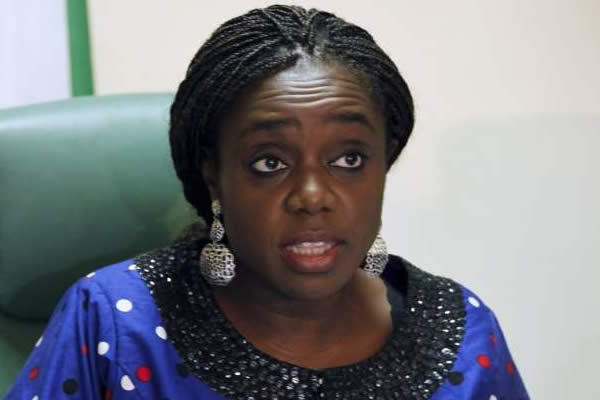 The Minister of Finance, Mrs. Kemi Adeosun, on Wednesday, stated that the Federal Government would apply the sum of $3bn in refinancing the legacy debts of the immediate past administration.
The Minister of Finance, Mrs. Kemi Adeosun, on Wednesday, stated that the Federal Government would apply the sum of $3bn in refinancing the legacy debts of the immediate past administration.
The outlay is part of the $5.5bn foreign loan being sourced from the international financial markets, according to the minister.
Adeosun, who appeared on a television programme in Abuja, according to a statement made available by her Special Adviser on Media, Mr. Oluyinka Akintunde, said the proposed $5.5bn loan was made up of refinancing of heritage debts to the tune of $3bn and new borrowing of $2.5bn for the 2017 budget.
The minister said the 2017 budget was facing liquidity problem, which explained in part the reasons that the Federal Government was seeking to borrow $5.5bn from the international financial market.
She said that the other reason was to get $3bn to refinance part of the domestic debt incurred by the government of President Goodluck Jonathan.
The minister stated that under Jonathan, the country’s debt rose from N7.9tn in June 2013 to N12.1tn in June 2015 despite the fact that “only 10 per cent of the budget was allocated to capital expenditure when oil price exceeded $120 per barrel.”
This means that the country’s debt rose by N4.2tn within the last two years that preceded the ascendance of President Muhammadu Buhari to the Presidency on May 29, 2015.
Adeosun stated, “Let me explain the $5.5bn borrowing because there have been some misrepresentations in the media in the last few weeks. The first component of $2.5bn represents new external borrowing provided for in the 2017 Appropriation Act to part finance the deficit in that budget.
“The borrowing will enable the country to bridge the gap in the 2017 budget currently facing liquidity problem to finance some capital projects.
“For the second component, we are refinancing existing domestic debt with the $3bn external borrowing. This is purely a portfolio restructuring activity that will not result in any increase in the public debt.”
She added, “Under this dispensation, we are not borrowing to pay salaries. If all we do is to pay salaries, we cannot grow the economy. This administration is also assiduously working to return Nigeria to a stable economic footing. In the light of this, the government adopted an expansionary fiscal policy with an enlarged budget that will be funded in the short term by borrowing.
“Nigeria’s debt to Gross Domestic Product currently stands at 17.76 per cent and compares favourably to all its peers. The debt to GDP ratio for Ghana is 67.5 per cent; Egypt is 92.3 per cent; South Africa, 52 per cent; Germany, 68.3 per cent; and the United Kingdom, 89.3 per cent.
“Nigeria’s debt to GDP ratio is still within a reasonable threshold. This administration will continue to pursue a prudent debt strategy that is tied to gross capital formation. This will be attained by driving capital expenditure in our ailing infrastructure which will in turn, unlock productivity and create the much needed jobs and growth.”
The minister emphasised that the Muhammadu Buhari-led administration was investing in critical infrastructural projects such as roads, railway and power in order to deliver a fundamental structural change to the economy that would reduce the nation’s exposure to crude oil.
She gave an assurance that the $5.5bn foreign loan was consistent with Nigeria’s Debt Management Strategy, whose main objective was to increase external financing with a view to rebalancing the public debt portfolio in favour of long-term external financing.
Some experts, however, opined that the debt to GDP ratio was not the best in measuring a country’s debt burden, saying that the use of debt to revenue ratio provided a better ratio for measuring a country’s debt burden as it showed the capacity to meet debt obligations.
In a telephone interview with our correspondent, a financial expert and Head of the Department of Banking and Finance, Nasarawa State University, Dr. Uche Uwaleke, stated that the debt to revenue ratio was a better measure.
According to the associate professor, the use of the index is a better way to measure a country’s capacity to pay debt and interest. He, however, said that the country hardly had any better option than to borrow, but insisted that debts should be tied to projects that were self-liquidating.
Uwaleke said, “There is no doubt that the country’s debt burden is high going by the debt to revenue ratio. There are other measures of the debt burden such as the debt to GDP ratio, which is currently around 18 to 19 per cent.
“The debt to revenue ratio is a better measure, because it measures the country’s ability to pay back. This challenge has been recognised by the government. The major risk we have in our debt burden is that we are carrying expensive local debts that are even of short-term nature.”
The country’s debt to revenue ratio rose from 35 per cent in 2015 to 60 per cent in 2016, according to the World Bank.

